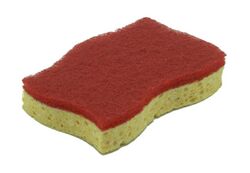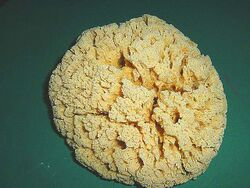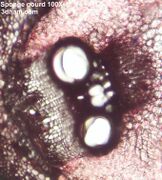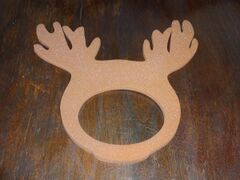Engineering:Sponge (material)

A sponge is a tool or cleaning aid made of soft, porous material. Typically used for cleaning impervious surfaces, sponges are especially good at absorbing water and water-based solutions.
Etymology
The word comes from the Greek word σπόγγος (spongos).[1]
History
The first references of sponges used for hygiene dates from the Ancient Greece . Competitors of the Olympic Games bathed themselves with sea sponges soaked in olive oil or perfume before competing. In the book Odyssey by the Greek poet Homer, the god Hephaestus cleans his hands, face, and chest with a sea sponge, and the servants in the Odysseus palace also used sea sponges to clean the tables after the meals the suitors of Penelope had there. The Greek philosophers Aristotle and Plato also mentioned sea sponges in both scientific and historic contexts in their works.[2][3] Ancient Greeks also used sea sponges tied to sticks as toilet paper, and washed them with sea water.[4]
Ancient Romans also used sea sponges extensively for hygiene and other uses. The belief that sponges had therapeutic properties led to its usage in medicine for cleaning wounds and treating disease.[2]
Sea sponges were used as tampons by females throughout history and are still used as a cheaper and more eco-friendly alternative to fibre ones.[5] However, researchers do not recommend using sea sponges as tampons, as they may contain dirt and microorganisms, especially if poorly sanitized.[6][7]
In the New Testament, a Roman soldier offers Jesus Christ a sponge soaked in vinegar on the tip of his spear (some versions say staff) for Jesus to drink during his crucifixion, as an act of mockery.[3][8][9]
Synthetic sponges were made possible to be manufactured only after the invention of polyester in 1941 and the commercial production of polyurethane foam in 1952.[10][11]
Material
Synthetic sponges can be made of polyester, polyurethane, or vegetal cellulose. Polyurethane is used in polyester sponges for their abrasive side. Polyester sponges are more common for dish washing and are usually soft and yellow.[12][13]
Vegetal cellulose sponges made of wood fiber are more used for bathing and skin cleaning, and are usually tougher and more expensive than polyester sponges. They are considered more eco-friendly than polyester sponges as they are biodegradable and made of natural materials.[12][14]
Harboring bacteria
thumb|right|200px|Bacteria from a kitchen sponge Because it is primarily made of wood fiber, a cellulose sponge can be a medium for the growth of harmful bacteria or fungi, especially when it is allowed to remain wet between uses.[15]
Cleaning
Several methods have been used to clean sponges. Studies have investigated the use of the microwave to clean non-metallic domestic sponges that have been thoroughly moistened. A 2006 study found that microwaving wet sponges for two minutes (at 1000 watt power) killed 99% of coliforms, E. coli, and MS2 phages, but Bacillus cereus spores required four minutes.[16] After some fires were caused by people trying to replicate the results at home, the study's author urged people to make sure their sponges were wet.[17] A 2009 study showed that the microwave and the dishwasher were both effective ways to clean domestic sponges.[16]
In economy
Caribbean and Mediterranean developing countries are the largest sponge exporters, whereas the largest importers are developed European and North-American countries. Tunisia is the world's main sponge exporter, exporting 90% of its sponge production. France is the main importer, being supplied by Tunisia, but France's sponge demand has fallen in recent years.[18]
| Exporters | 1981 | 1982 | 1983 | 1984 | 1985 | 1986 |
|---|---|---|---|---|---|---|
| Tunisia | 74t | 71t | 84t | 81t | 91t | 88t |
| Cuba | 36t | 33t | 38t | 33t | 41t | 41t |
| France | 25t | 26t | 33t | 31t | 35t | 30t |
| Greece | 32t | 42t | 36t | 27t | 32t | 22t |
| Bahamas | - | 8t | 21t | 8t | 3t | 14t |
| Turkey | 11t | 8t | 7t | 8t | 1t | 1t |
| Egypt | 5t | 4t | 4t | 2t | 4t | 8t |
| Japan | - | 6t | 4t | 1t | 1t | 6t |
| Philippines | 9t | 4t | 5t | 6t | 6t | 4t |
| Libya | - | - | - | 6t | 3t | - |
| TOTAL | 192t | 202t | 232t | 213t | 245t | 225t |
Gallery
A Luffa aegyptiaca sponge section magnified 100 times
See also
- Dishcloth
- Ethylene-vinyl acetate – material that craft foam is made from ethylene-vinyl and acetate
- Luffa aegyptiaca
- Sponge metal
References
- ↑ "Henry George Liddell, Robert Scott, A Greek-English Lexicon". http://www.perseus.tufts.edu/hopper/text?doc=Perseus%3Atext%3A1999.04.0057%3Aalphabetic+letter%3D*s111%3Aentry+group%3D61%3Aentry%3Dspo%2Fggos.
- ↑ 2.0 2.1 Inc., The Sea Sponge Company™. "The History of the Sea Sponge". https://www.seaspongecompany.com/pages/sea-sponge-history.
- ↑ 3.0 3.1 "Natural Sea Sponges and sponge diving history" (in en). http://www.kalymnos-shop.gr/en/blog/natural-sponges/natural-sea-sponges-and-sponge-diving-history.
- ↑ "Como era feita a higiene bucal antes da pasta de dente?" (in pt-BR). Mundo Estranho. https://mundoestranho.abril.com.br/historia/como-era-feita-a-higiene-bucal-antes-da-pasta-de-dente/.
- ↑ "2017's Top 5 Sea Sponge Menstrual (Soft) Tampons | Reviews" (in en-US). https://menstrualcupreviews.net/sea-sponge-menstrual-soft-tampons-product-reviews/.
- ↑ "Compliance Policy Guides - CPG Sec. 345.300 Menstrual Sponges" (in en). U.S. Food and Drug Administration. https://www.fda.gov/ICECI/ComplianceManuals/CompliancePolicyGuidanceManual/ucm123803.htm.
- ↑ "Why you shouldn't use sea sponges as a natural alternative to tampons" (in en-GB). Metro. 2016-05-20. http://metro.co.uk/2016/05/20/why-you-shouldnt-use-sea-sponges-as-a-natural-alternative-to-tampons-5894193/.
- ↑ "Bible Gateway passage: Matthew 27:48 - New International Version". https://www.biblegateway.com/passage/?search=Matthew+27:48&version=NIV.
- ↑ "Was the act by the Roman soldier of placing a sponge on the tip of his spear, dipping it in gall and offering it to Jesus on the cross an act of mercy or mockery?" (in en). kansascity. http://www.kansascity.com/living/religion/article438813/Was-the-act-by-the-Roman-soldier-of-placing-a-sponge-on-the-tip-of-his-spear-dipping-it-in-gall-and-offering-it-to-Jesus-on-the-cross-an-act-of-mercy-or-mockery.html.
- ↑ "Polyurethane Foam Kitchen Sponge. History of Origin — Vortex Power". http://www.vortex-power.com/eng/home2.html.
- ↑ "History of Polyester | What is Polyester" (in en-US). http://www.whatispolyester.com/history.html.
- ↑ 12.0 12.1 S.r.l., Corazzi Fibre. "Polyester sponge and Cellulose sponge" (in en-US). http://www.corazzi.com/pulizia-domestic/dom-converters/sponge-scourers/polyester-sponge-and-cellulose-sponge/.
- ↑ "Polyurethane Sponge - Dynathane | PAR Group". https://www.par-group.co.uk/rubber-and-polyurethane/polyurethane-engineering/polyurethane-sponge-dynathane/.
- ↑ Hickman, Matt (2017-08-21). "What's the difference between cellulose sponges and those other kitchen sponges?". https://www.mnn.com/your-home/at-home/questions/whats-the-difference-between-cellulose-sponges-and-those-other-kitchen-s.
- ↑ "Reducing bacteria in household sponges". Journal of Environmental Health 62: 18–22. http://search.proquest.com/openview/8508f6cdd54d5692d03ff82c87ed844f/1?pq-origsite=gscholar.
- ↑ 16.0 16.1 "Hygiene in the home kitchen: Changes in behaviour and impact of key microbiological hazard control measures". Food Control 35: 392–400. doi:10.1016/j.foodcont.2013.07.026. http://www.sciencedirect.com/science/article/pii/S0956713513003745.
- ↑ "Microwave 'sterilisers' warning". 24 January 2007. BBC News.
- ↑ "SPONGES: WORLD PRODUCTION AND MARKETS". http://www.fao.org/docrep/field/003/AC286E/AC286E04.htm.








